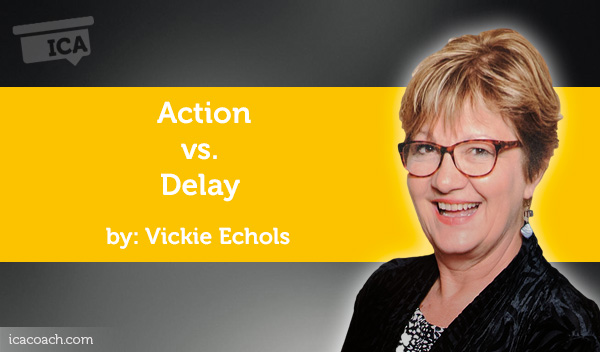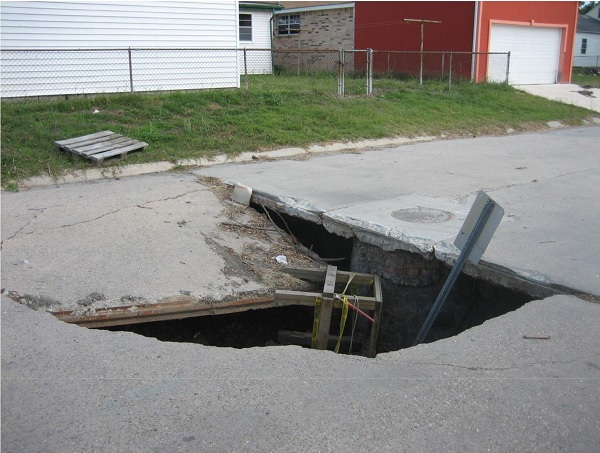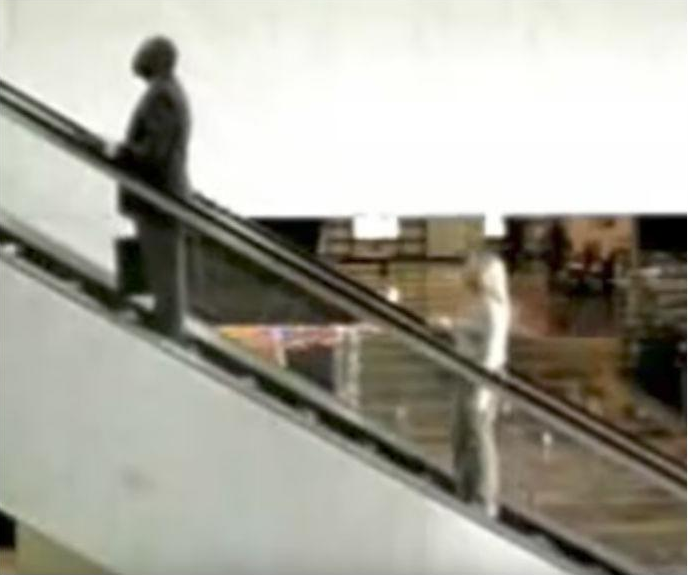
A Coaching Power Tool Created by Vickie Echols
(Leadership and Life Coach, UNITED STATES)
A pothole on the road of life can cause a huge dilemma! Getting stuck or falling into a hole of self-paralysis is a frustrating full stop! When a collapse, a crater or a careless fall causes you to spin your wheels, you can find yourself wondering how to move on. The ability to move forward might seem out of reach, but with mindful coaching and clarity, the delay can be a temporary detour on the way to finding your intended destination.

Action and delay hold significant properties of energy:
These extreme states of mind affect your motivation, intention and ultimately your outcomes, so becoming more aware of these specific states can make a huge difference.
In order to understand how these states of mind affect you, it is helpful to use the concept of a spectrum to analyze your present state. Rather than just thinking of momentum as a stop and go function, the idea of a spectrum will help you see that feelings around action and delay may include a wide range of reactions. As you ponder the question of where you land on the spectrum of intention, consider what we mean by action and delay.

What is Delay?
Delay is a significant barrier, and like a hole in the road, can leave us feeling paralyzed or stuck. Momentum slows and energy levels drop; delay is a huge distraction. It may, however, not show up as this extreme. Sometimes the feelings of delay may land somewhere else on a spectrum of good intentions, and show up as stress, worry, procrastination or hesitation. In any case, we can end up feeling like we’re standing on a broken escalator , completely able to move forward, but we don’t!
The causes for delay fall into three categories: Fear, Judgement, and Reluctance.
Fear is a really unpleasant emotion, but it can serve us well if we actually are in physical or emotional danger. It protects us from legitimate threats. However, fear creeps in most often for no good reason and throws up a smoke screen of faulty thoughts. Fearful emotions can hijack the rational brain and cause a great deal of delay.
Judgement is an action we use many times during the day, and some careers and life experiences actually depend it. We all make judgements all the time. However judgemental thinking can cripple and corrode the best of intentions when we are overly critical in an unhelpful and uncaring way. Judgemental criticism deteriorates confidence and deals out dangerous delays.
Reluctance is the opposite of commitment, and can serve us well if the step forward requires a large amount of responsibility, skill or uncertainty. However if a reasonable assessment of the situation reveals a decision to go forward, reluctance can become a huge barrier to the opportunities and the treasure that lies ahead.
What is Action?
Action is a powerful energy, which propels us forward, serving as a catalyst to create change and empowerment! We feel this energy from achieving even the smallest of goals, so action – of any kind – can serve us well.
Actions may be minute or monumental! Even the smallest thought can shift us toward an action, which includes reading, meditating, reflecting, writing, talking, coaching, walking, mentoring. These actions create a movement forward and coupled with structure, strategy and accountability can make a magnificent difference.
The reasons for action fall into these categories: confidence, acceptance and openness.
Confidence is described as a belief in your ability to succeed, however striking a healthy balance can be challenging. Too much of it and you can come off as cocky and stumble into unforeseen obstacles, but having too little can prevent you from taking risks and seizing opportunities—in school, at work, in your social life, and beyond.1
Acceptance may show up in these three ways: 1) developing a different relationship to your experience, by allowing yourself to see and live and let it be; 2) shifting from “not wanting” toward “opening,” and allowing a chain reaction of habitual responses to be altered at the first link; and 3) repeatedly practicing over time to notice things, like anxiety, which may show up as tightness in the chest, or sadness as heaviness in the shoulders, and bringing attention/awareness to the sensations that accompany difficult experiences, learning to relate differently to such experiences in each moment.2
Openness can be described as a tool for developing capability and a road-map for continuous improvement, and can be defined by evidence of courage, participation and honesty.
Echos of Action: An example from Life
In order to illustrate the impact of action and delay in life experience, consider these thoughts captured from an interview. Notice from this oral history how even when a person takes action, she may not see the impact of those actions until years later.
Ethel graduated from Longview High School in Texas in 1970 after choosing to leave Womack, the segregated high school for children of color. In a recent interview, she spoke matter of factly, but also as if searching for the memories she was recalling.
Sometimes during the conversation she was surprised and corrected herself as she spoke.
So I
Transferred without my parents knowing. So because… uh when they did find out they weren’t very pleased that I did it without them knowing.
I don’t remember a lot about it—kind of blanked all that out. I don’t remember
anything that was Aaaall bad.
Because basically the black kids all stayed together …it was still segregated we all fell
in there together. And
I had a few friends. I didn’t really have any friends.
I chose not to be in the limelight
And so a typical day was that I was seen but not seen
you understand what I mean?
The football players were in the spotlight, but
they were already in the spotlight at Womack. They were great football players so I
think they felt like they left one school and went to another and they were the jocks.
After I got there and stayed there – I hated that I went. Because of the fact if I had
stayed at Womack those friends I had made—because I didn’t have any friends uh at
Longview High School — and then if I had stayed at Womack – I would have been
seen. I wouldn’t have been walking around seen but not seen.
She later explained that the action of moving to the new school by choice was very unlike her at the time, describing herself as quiet and accepting of circumstances. Ethel Johnson went on to become a public school teacher and taught in Longview public schools. She describes those experiences early in life as something that influenced the person she is now, as someone who seeks out opportunities for action, to step forward, to speak out – and to be seen.
Ethel Johnson, Longview High School Class of ‘70, chose to leave Mary C. Womack to attend LHS during desegregation by choice. Excerpts from the interview to follow were recorded by Elizabeth M. Melton, Ph.D. Candidate, Department of Communication, The University of North Carolina at Chapel Hill. What comes up for you when you read the reflections of Ethel Johnson’s experiences, actions and the outcomes she experienced? What can you imagine would be different if she had not taken this action?
Coaching Application
Overcoming or navigating delays and obstacles to action is a common topic among clients seeking a coach. Since action is a life line for the coaching practice, it is a significant construct to understand.
Beliefs – particularly hidden beliefs are the roots of our actions, the habits of mind where convictions, confidence and courage can bloom or die. Many times hidden beliefs, that have cultivated from our experiences, hold us back without us even realizing they exist. These pesty falsehoods and negative lies whispered by the inner critic cause a constant grind on the wheels of action and divert us toward delay.
Uncovering them through coaching conversations will allow you to face the hidden beliefs which cripple – diminishing their power – and to nurture that which serves you well.
When taking on a client who wants support in sorting out action and delay, it is important to equip yourself with tools to support change and insights into how clients can shift into a commitment of action.
1. Goal Setting Process
a. Clarity of the goal and challenges
b. Definition of the long term and short term
c. Decide when this happens
2. Record the Journey
a. Jot notes on a weekly basis of the previous week, noting steps forward and backward and reasons for these actions.
b. Keep a small notepad, or a digital notes tool as a place for jotting
thoughts, actions and acknowledgements of progress.
3. Rewards
a. Design an experience or a treat for yourself to acknowledge action.
b. Create a list of benefits you will gain and post it in plain site.
4. Reminders
a. Set up a mini action plan to update daily, such as a mirror.
b. Find a mobile app set to remind you with notifications.
c. Partner with a friend/partner who will agree to check in and give support. Make sure they are a positive encourager!
Reflection Questions
In addition to the use of these tools, significant questions are available to support your clients. Coaches are encouraged to spend some time reflecting on these questions as they pertain to themselves, because while exploring these questions and reflecting on your own answers, you will better understand the possible range of behaviors, intentions and actions of your clients.
Reframe Perspectives:
General Questions to consider are:
1 “Confidence | Psychology Today.” Accessed 30 Nov. 2017.
2 “Three Ways Acceptance Helps You Work with Difficult Emotions ….” 18 May. 2016, Accessed 30 Nov. 2017.
